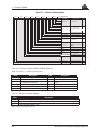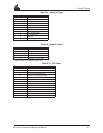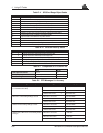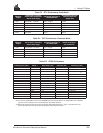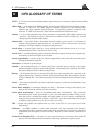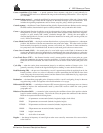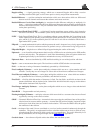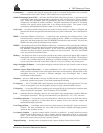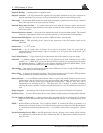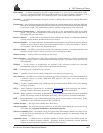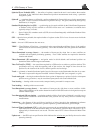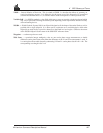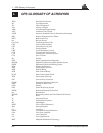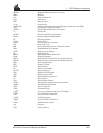
K GPS Glossary of Terms
246 MiLLennium Command Descriptions Manual
Spherical Error Probable (SEP) — the radius of a sphere, centred at the user’s true location, that contains
50 percent of the individual three-dimensional position measurements made using a particular
navigation system.
Spheroid — sometimes known as ellipsoid; a perfect mathematical figure which very closely approximates
the geoid. Used as a surface of reference for geodetic surveys. The geoid, affected by local gravity
disturbances, is irregular.
Standard Positioning Service (SPS) — a positioning service made available by the United States Department
of Defence which will be available to all GPS civilian users on a continuous, worldwide basis
(typically using C/A Code).
SV — Space Vehicle ID, sometimes used as SVID; also used interchangeably with Pseudo-Random Noise
Number (PRN).
SEP — spherical error probable; the required radius of a sphere so that 50% of a set of events occur inside the
boundary.
Static — the user’s GPS antenna does not move.
TDOP — Time Dilution of Precision - A numerical value expressing the confidence factor of the position
solution based on current satellite geometry. The lower the TDOP value, the greater the confidence
factor.
Three-dimensional coverage (hours) — the number of hours-per-day when four or more satellites are
available with acceptable positioning geometry. Four visible satellites are required to determine
location and altitude.
Three-dimensional (3D) navigation — navigation mode in which altitude and horizontal position are
determined from satellite range measurements.
Time-To-First-Fix (TTFF) — the actual time required by a GPS receiver to achieve a position solution. This
specification will vary with the operating state of the receiver, the length of time since the last
position fix, the location of the last fix, and the specific receiver design.
Track — a planned or intended horizontal path of travel with respect to the Earth rather than the air or water.
The track is expressed in degrees from 000° clockwise through 360° (true, magnetic, or grid).
Track made good — the single resultant direction from a point of departure to a point of arrival or subsequent
position at any given time; may be considered synonymous with Course Made Good.
True bearing — bearing relative to true north; compass bearing corrected for compass error.
True heading — heading relative to true north.
Two-dimensional coverage (hours) — the number of hours-per-day with three or more satellites visible.
Three visible satellites can be used to determine location if the GPS receiver is designed to accept an
external altitude input.
Two-dimensional (2D) navigation — navigation mode in which a fixed value of altitude is used for one or
more position calculations while horizontal (2D) position can vary freely based on satellite range
measurements.
Undulation — the distance of the geoid above (positive) or below (negative) the mathematical reference
ellipsoid (spheroid). Also known as geoidal separation, geoidal undulation, geoidal height.
Universal Time Coordinated (UTC) — this time system uses the second-defined true angular rotation of the
Earth measured as if the Earth rotated about its Conventional Terrestrial Pole. However, UTC is
adjusted only in increments of one second. The time zone of UTC is that of Greenwich Mean Time
(GMT).
Update rate — the GPS receiver specification which indicates the solution rate
provided by the receiver when
operating normally.




